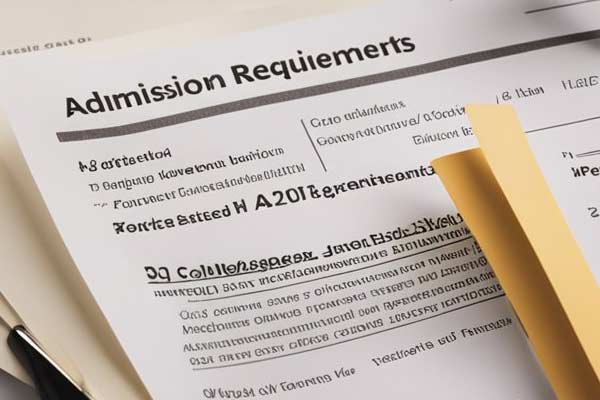College Admission Requirements: What You Need to Know
College admission is applying for and being accepted into a college or university. It is a competitive process, and many factors are considered when evaluating applicants.
The criteria for admission can differ based on the school and the specific program, but most colleges and universities use similar guidelines when evaluating potential students.
The college application process typically involves submitting an application, transcripts, test scores, essays, and letters of recommendation.
Admissions committees consider various factors when evaluating applicants, including academic achievements, extracurricular activities, community involvement, and personal characteristics.
One of the most essential factors in the college admission process is meeting admissions requirements. These requirements can include minimum GPA and test score standards, as well as specific courses or subjects that must be completed in high school.
Admissions requirements can vary widely depending on the school and the program, so students must research the needs of each school they are considering.
In addition to meeting admissions requirements, students may also need to complete additional steps in the college admission process, such as interviews or auditions. These steps are typically required for specialized programs, such as performing arts or athletics.
Types of Applications
When it comes to applying for college, there are several types of applications that students can choose from. The two most common types of applications are the Common Application and the Coalition Application.
The Common Application is a universal college application used by more than 900 colleges and universities in the United States and globally. It allows students to apply to numerous schools with a single application.
The Common Application includes a general application and a school-specific supplement for each college or university to which a student applies.
🌟 Hey Students! 🚀 Ready for the ultimate experience? Join us on Studentsinside.com's Facebook, YouTube, WhatsApp, and LinkedIn. Click now for tips, fun, and success vibes! 🌈✨ #StudentLife #JoinUs
One of the benefits of using the Common Application is that it allows students to save time by filling out one application for multiple schools.
Furthermore, the Common Application offers a user-friendly platform, simplifying the application process for students.
Coalition Application
The Coalition Application is a standardized college application that’s embraced by more than 150 colleges and universities across the United States. Much like the Common Application, it empowers students to submit one application to multiple schools.
The Coalition Application offers a unique feature that enables students to build an online portfolio to display their accomplishments and experiences.
This portfolio is a valuable addition to a student’s application, offering colleges and universities extra insights and information.
Application Deadlines
When applying to college, it is crucial to pay close attention to application deadlines. There are typically three application deadlines: early action, early decision, and regular decision.
Early action and decision deadlines are typically in November or December, while regular decision deadlines are typically in January or February.
Early action and early decision deadlines are non-binding, which means that students can apply to multiple schools and have until May 1st to decide which school to attend.
Regular decision deadlines are binding, which means that students are committing to participate in the school if they are accepted.
Transfer Students
For transfer students, the application process is slightly different. Transfer students typically apply directly to the college or university they wish to attend.
Transfer students must meet different application requirements depending on the school they are applying to.
However, these requirements typically include submitting transcripts from all colleges and universities previously attended, providing letters of recommendation, and crafting a personal statement.
Academic Requirements
To be admitted to a college or university, applicants must meet academic requirements. These requirements typically include a high school transcript, standardized test scores, and specific course requirements.
High School Transcript
The high school transcript is a crucial component of the college application process. Colleges look at an applicant’s grades, the difficulty of the courses taken, and the overall GPA. A weighted GPA is often used to account for advanced courses, such as AP or IB exams.
Applicants should take challenging courses in core subjects, such as English, math, science, and foreign languages. A solid academic performance in these subjects indicates an applicant’s ability to succeed in college.
Standardized Test Scores
Colleges may require applicants to submit scores from standardized tests, such as the ACT or SAT. These tests measure an applicant’s knowledge and skills in math, English, and reading.
A strong performance on these tests can be a significant factor in the admissions process.
However, some colleges have moved away from requiring standardized test scores and instead focus more on an applicant’s high school transcript and other factors.
Course Requirements
Colleges may have specific course requirements that applicants must meet to be considered for admission. These requirements may include several years of English, math, science, or foreign language courses.
Applicants should review the course requirements for each college they are interested in and ensure they have taken the necessary courses. Some colleges may also have additional requirements, such as a certain number of credits in a particular subject area.
Additional Requirements
In addition to the general admission requirements, many colleges and universities require applicants to submit additional materials to be considered for admission.
These materials can include extracurricular activities, letters of recommendation, a college essay, and interviews.
Extracurricular Activities
Extracurricular activities are a way for students to showcase their interests, passions, and skills outside the classroom.
Colleges and universities often look for students who are well-rounded and have demonstrated leadership, teamwork, and commitment through their involvement in activities such as sports, clubs, volunteer work, and internships.
When submitting extracurricular activities, it is crucial to provide a brief description of each activity and the amount of time committed to each. It is also helpful to highlight any leadership positions or awards received.
Letters of Recommendation
Recommendation letters offer valuable information about a student’s academic skills, personal qualities, and potential to excel in college.
Nearly all colleges and universities mandate the submission of at least one recommendation letter from a teacher, counselor, or another academic expert.
When requesting a letter of recommendation, it is vital to choose someone who knows the student well and can speak to their strengths and accomplishments.
It is also essential to provide the recommender with a clear deadline and any necessary forms or instructions.
College Essay
The college essay, also known as the application essay, provides students with an opportunity to display their writing abilities and individuality.
It serves as a means to distinguish among candidates who have comparable academic records and participation in extracurricular activities.
When writing a college essay, it is vital to choose a topic that is meaningful and personal to the student. The essay should also be well-written, organized, and free of errors.
Interviews
Many colleges and universities include interviews as a part of their application procedure. These interviews may occur face-to-face, over the phone, or through video calls.
During the interview, students may be asked about their academic background, extracurricular activities, and future goals.
It is crucial to prepare for the interview by researching the college or university and practicing potential questions.
Specific College Requirements
Harvard Admission Requirements
Harvard University is one of the most prestigious universities in the world. To gain admission to Harvard, students must meet specific requirements.
To apply to Harvard University, students need to provide their SAT or ACT scores, as well as two SAT Subject Test scores. Additionally, the university requests high school transcripts, essays, and letters of recommendation from applicants.
Harvard University doesn’t have a strict minimum GPA requirement for admission, but most accepted students typically have a GPA of approximately 4.18.
Additionally, Harvard’s admission process places a strong emphasis on qualities such as leadership skills, participation in extracurricular activities, and a dedication to community service among prospective students.
Architecture Major Requirements
For students interested in pursuing an architecture major, there are specific requirements that must be met.
Architecture programs typically require students to have a strong background in math, science, and art.
Students must also submit a portfolio of their work, which showcases their creativity and design skills.
Some architecture programs may also require students to complete an internship or co-op program, allowing them to gain real-world experience in the field.
Additionally, students may need to pass a licensing exam to become a licensed architect.
Application Logistics
When applying for college, specific logistics need to be taken care of.
Application Fee and Waivers
Many colleges ask for an application fee when you apply. The amount of this fee can differ from one college to another, but it’s usually about $50.
Nonetheless, specific colleges provide fee waivers for students who have financial difficulties.
To apply for an application fee waiver, students usually need to submit a form and provide proof of their financial situation.
It is essential to check with the college admissions office to see if they offer application fee waivers and what the requirements are.
Contact Information
It is essential to have the correct contact information for the college admissions office. This includes email addresses, phone numbers, and mailing addresses.
Students should double-check the contact information before submitting their application to ensure it is correct.
If there are any questions or issues with the application, students should contact the college admissions office for assistance.
Financial Aspects
Regarding college admission requirements, financial aspects play a crucial role in the decision-making process.
Students and their families need to consider various factors to ensure they can afford the cost of attendance. Here are some key financial aspects to keep in mind:
Scholarships
Scholarships are financial aid that can be paid. They are awarded based on merit, need, or other criteria and can significantly reduce the cost of attendance.
The college or university offers some scholarships, while external organizations provide others.
To improve the odds of securing scholarships, students should actively search for and apply to numerous opportunities.
Additionally, consulting their high school guidance counselor or the college’s financial aid office for scholarship details can be beneficial.
Financial Aid
Financial aid comes in various forms to help students cover their college expenses. This assistance includes grants, loans, and work-study programs.
Scholarships are typically awarded to students facing financial challenges, and they do not require repayment.
In contrast, loans have to be paid back, often with added interest. Work-study programs allow students to take up part-time campus jobs.
To request financial assistance, students must complete the Free Application for Federal Student Aid (FAFSA). This form helps determine whether students qualify for federal and state financial aid programs.
Additionally, students should explore additional financial aid opportunities offered by the college or university they plan to attend.
It’s crucial to recognize that financial aid packages can differ significantly among colleges and universities. To make an informed decision, students should carefully examine and compare the details of each package to determine which one provides the best value.
Special Circumstances
College admissions processes can be complicated, and sometimes, students face special circumstances that require additional attention.
COVID-19 Pandemic Impact
Students’ lives have been greatly affected by the COVID-19 pandemic, leading to changes in their academic performance and extracurricular activities.
To address this, numerous colleges and universities have modified their admission criteria.
Some colleges have made standardized test scores optional for the 2022-2023 academic year, while others have extended application deadlines or allowed students to submit additional materials to explain any negative impacts of the pandemic on their academic performance.
It is crucial for students to research individual colleges’ policies regarding the pandemic and to communicate any exceptional circumstances in their application materials.
Transfer Student Requirements
Applying to colleges and universities can be especially tricky for transfer students. Alongside the usual admission criteria, they have to submit transcripts from all the schools they’ve been to before.
Some colleges have specific requirements for transfer students, such as a minimum number of transferable credits or a minimum GPA. It is essential for transfer students to research individual colleges’ transfer requirements and to communicate any exceptional circumstances in their application materials.
Preparation Timeline
Preparing for college admission can be a daunting task, but with the proper timeline, it can be manageable.
Here is a timeline of what students can do during their junior and senior years of high school to ensure they are ready for college admission.
Junior Year
In junior year, students need to concentrate on getting ready for standardized exams like the SAT or ACT.
It is recommended that students start studying for these tests in their sophomore year or the summer before their junior year. Taking the tests for the first time in the fall of their junior year is ideal.
In addition to preparing for standardized tests, students should also start researching colleges and universities they are interested in attending.
They can attend college fairs and visit college websites to gather information about admission requirements, campus life, and academic programs.
Another vital aspect of junior year is maintaining good grades. Colleges and universities will review a student’s transcript, so it is essential to perform well academically.
Senior Year
During the senior year, students should finalize their college list and begin submitting applications. It is recommended that students apply for early action or early decision by November of their senior year. Regular decision deadlines are typically in January or February.
Apart from applying for college, students should also remember to seek financial help. They need to complete forms like FAFSA and CSS Profile if required. It’s essential to monitor the due dates for financial aid applications.
Students should also plan to visit college campuses and attend interviews if required. It is recommended that students visit campuses during the fall of their senior year.
FAQs
Here are some frequently asked questions about college admission requirements:
What is the difference between early decision and early action?
Early decision is a binding agreement between the student and the college, meaning that if accepted, the student must attend that college.
Early action is non-binding, meaning the student can still choose to attend a different college if accepted. However, both early decision and early action have earlier application deadlines than regular decisions.
What is the Common Application?
The Common Application simplifies the college application process for students by providing a single, standardized application that can be used to apply to more than 900 colleges and universities across the United States. This streamlines the application process, making it more efficient and less time-consuming for students.
What is the FAFSA?
The FAFSA is a required form for students seeking federal financial aid and, in some cases, state and school-based aid.
This form gathers details about the student’s and their family’s income and assets to evaluate whether they qualify for financial assistance.
What is the CSS Profile?
The CSS Profile is a form that specific colleges and universities use to assess if a student qualifies for financial aid from their school.
This form requests more specific financial details from the student and their family, going beyond what the FAFSA typically requires.
What is demonstrated interest?
Demonstrated interest refers to a student’s level of engagement with a college, such as visiting the campus, attending information sessions, or contacting admissions officers. Some colleges consider demonstrated interest in their admissions decisions.
What is a waitlist?
A waitlist is a list of students who are qualified for admission to a college but have yet to be offered a spot in the incoming class. If spots become available due to students declining their offers of admission, students on the waitlist may be offered admission.
What is a deferral?
A deferral is when a college postpones deciding on a student’s application, usually from an early decision or early action to a regular decision. It means the college is still considering the student’s application but has yet to decide.








